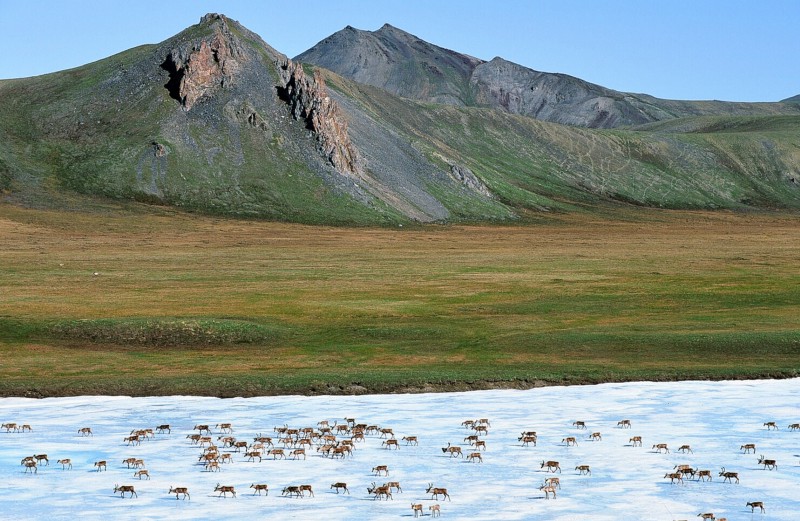
Americans speak out in opposition to drilling in Arctic Refuge
There is no reason to despoil a pristine wilderness for last century fuels.
June 19 closed out the first 60-day public comment period for the Bureau of Land Management’s (BLM) proposal to allow oil drilling in the coastal plain of the Arctic National Wildlife Refuge.
Environment America joined a broad coalition of native, faith, sportsmen, veteran and other environmental organizations to deliver nearly 700,000 public comments in opposition to the oil drilling proposal.

Environment America’s Stop Drilling Campaign Director, Erik DuMont, gives verbal comments to the BLM at a June 15th hearing in Washington, D.C.; Photo by Johnathan Comer
The Arctic National Wildlife Refuge is a place unlike any on earth: a pristine and undeveloped Arctic wilderness, a place “where the earth and its community of life are untrammeled by man.” The Arctic Refuge is too special a place for us to allow it to be despoiled by industrial oil development, especially at a time when the U.S. and the world are transitioning away from fossil fuels to drive our economies.
The Arctic Refuge is Wild and Pristine
In the Arctic National Wildlife Refuge, we can watch one of the most spectacular wildlife migrations anywhere in the world: The Porcupine Caribou Herd of nearly 200,000 animals makes their yearly trek to the coastal plain to calve.
The coastal plain has exactly what they need. It has protein-rich cotton grass, which a nursing mother needs for a growing calf. It has ocean breeze, vital to keep hordes of mosquitoes away — this is not a minor point, as calves can and do succumb to mosquitoes every year. Finally, the coastal plain is a relatively predator-free environment. When the calves are at their most vulnerable, one of their primary predators, wolves, are up in the foothills of the Brooks Range, having their pups. If the mothers of the Porcupine Caribou herd are displaced by an industrial oil development in their calving grounds, scientists predict it will lead to a sharp decline in herd productivity and numbers.
In addition to the caribou, the refuge is home to musk oxen, polar bears, grizzly bear, golden eagles and birds from all 50 states and six continents.
The Gwich’in people of Alaska and Canada, who were in D.C. to defend this area, call this area itzhik gwaat’san gwandai goodlit — “the sacred place where life begins.”

Photo by Ken Madsen
It’s a Wildlife Refuge, Not an Oil Reserve
Industrial oil development is not compatible with the values and the purpose of a wildlife refuge. According to the National Wildlife Refuge system, wildlife refuges are managed following the guidance of “Aldo Leopold’s teachings that land is a community of life and that love and respect for the land is an extension of ethics.” Needless to say, disrupting an untouched and pristine landscape with industrial oil exploration and development does not demonstrate respect for the land or the animals. A wildlife refuge is intended as a place for wildlife to live free from the man-made impacts of an increasingly paved, drilled and developed world.
We know already that industrial oil development creates spills. Spills on the north slope of Alaska in Prudhoe Bay (less than 100 miles to the west of the Refuge) are tracked, with an average around 450 spills a year or 1.2 per day.
We’ve also seen that caribou tend to avoid areas where industrial oil development has taken place while calving. Migrating caribou walk down gravel roads and past pipelines, but studies have shown us that not only do the caribou mothers avoid these areas for calving, but doing so places them in less desirable locations and has led to decreases in their reproductive productivity.
We Don’t Need the Oil
As a nation, we need to question why additional industrial oil development, especially in such a special place, is being pursued at all. Clean, renewable energy is quickly becoming the most abundant and cheapest energy source, and in a time of increasing abundance, the future need for more oil diminishes almost daily. Last year, by far the biggest net new capacity added to our grid was from wind and solar. With clean, abundant and economical energy choices available from sun and wind, the argument that we need to continue extracting energy from our most pristine areas cannot be convincingly made.
It’s for all these reasons and more that the nearly 700,000 Americans were motivated to comment against oil drilling in this national wildlife refuge. Consistent with public polling, they reached the inescapable conclusion that industrial oil development has no place in the Arctic National Wildlife Refuge.
Topics
Authors
Steve Blackledge
Senior Director, Conservation America Campaign, Environment America
Steve directs Environment America’s efforts to protect our public lands and waters and the species that depend on them. He led our successful campaign to win full and permanent funding for our nation’s best conservation and recreation program, the Land and Water Conservation Fund. He previously oversaw U.S. PIRG’s public health campaigns. Steve lives in Sacramento, California, with his family, where he enjoys biking and exploring Northern California.
Find Out More

Why we should save the bees, especially the wild bees who need our help most

Why Alaska’s NPR-A, site of the Willow Project, deserves protection

Bank of America said it would stop financing drilling in the Arctic Refuge. Now it’s backtracking.


